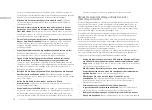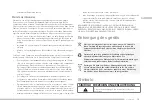
9
cramer.eu
EN
any chance that the tree may not fall in the desired direction or it may rock back
and bind the saw chain, stop cutting before the felling back cut is complete and
use wedges of wood, plastic or aluminium to open the cut and drop the tree along
the desired line of fall. When the tree begins to fall, remove the chain saw from
the cut, stop the motor, put the chain saw down, and then use the retreat path as
planned. Be alert of overhead limbs falling and watch your footing.
Limbing a tree
(see
Figure 11
)
Limbing is removing the branches from a fallen tree. When limbing, leave the larger
lower limbs to support the log off the ground. Remove the small limbs in one cut.
Branches under tension should be cut from the bottom up, to avoid binding the
chain saw.
Bucking a log
(see
Figure 12-15
)
Bucking is cutting a log into lengths. It is important to make sure your footing is
firm and your weight is evenly distributed on both feet. When possible, the log
should be raised and supported by the use of limbs, logs or chocks.
Follow the simple direction for easy cutting:
•
When the log is supported along the entire length, it is cut from the top
(over buck).
•
When the log is supported on one end, cut 1/3 of the diameter from the
underside (under buck). Then make the finished cut by over bucking to
meet the first cut.
•
When the log is supported on both ends, cut 1/3 of that diameter from the
top (over buck). Then make the finished cut by under bucking the lower 2/3
to meet the first cut.
•
When bucking on a slope, always stand on the uphill side of the log. When
cutting through, to maintain complete control, release the cutting pressure
near the end of the cut without relaxing your grip on the chain saw handles.
Do not let the chain contact the ground. After completing the cut, wait for the
saw chain to stop before you move the chain saw. Always stop the motor before
moving from tree to tree.
MAINTENANCE
WARNING!
Always remove the battery pack from the machine before
checking the chain tension or making adjustments to the chain.
Wear protective gloves while touching the chain, bar or areas
around the chain.
Adjusting the chain tension
(see
Figure 2-7
)
•
Loosen the chain cover lock nuts with the supplied wrench. The chain cover
lock nuts do not have to be completely removed in order to adjust the chain
tension.
•
Rotate the chain adjustment screw clockwise to increase the chain tension
and rotate counterclockwise to decrease the chain tension.
•
Once the chain is at the desired tension, tighten the chain cover lock nuts.
Replacing the bar and chain
(see
Figure 3-7
)
•
Remove the battery from the chain saw.
•
Remove the two chain cover lock nuts from chain cover by rotating them
counterclockwise with the wrench.
•
Remove the chain cover from the mounting surface.
•
The bar and chain can now be removed by lifting it away from the main
body of the saw and releasing the chain from the sprocket.
•
Remove the old chain from the bar.
•
Lay out the new saw chain in a loop and straighten any kinks. The cutters
should face in the direction of chain rotation. If they face backwards, turn
the loop over.
•
Place the chain drive links into the bar groove.
•
Position the chain so there is a loop at the back of the bar.
•
Hold the chain in position on the bar and place the loop around the
sprocket.
•
Fit the bar flush against the mounting surface so that the bar studs are in
the long slot of the bar. Ensure that the chain is over the sprocket.
•
Replace the chain cover.
•
Remove all slack from the chain by turning the chain a djustment screw
Summary of Contents for 40CS12
Page 310: ...DISTRIBUTOR INFO cramer eu ...










































